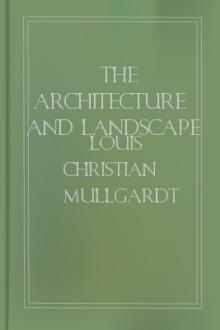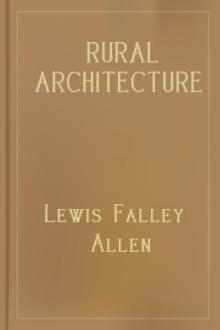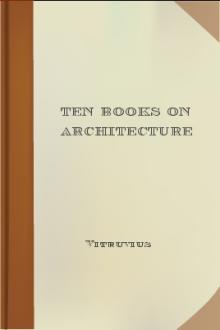The Architecture and Landscape Gardening of the Exposition, Louis Christian Mullgardt [the kiss of deception read online txt] 📗

- Author: Louis Christian Mullgardt
- Performer: -
Book online «The Architecture and Landscape Gardening of the Exposition, Louis Christian Mullgardt [the kiss of deception read online txt] 📗». Author Louis Christian Mullgardt
Over six hundred acres are comprised in the elongated site on which the Exposition stands. Millions of people from all parts of the world have made pilgrimage to this realm of phantasy, and many thousands more are on their way, determined to bask in the radiance of Good Will toward All Mankind, which this Mecca of Peace, Enlightenment, Beauty, and Inspiration for a better and greater future gives forth. Its purposeful influence is destined to serve perpetually beneficent cause in the furtherance of unified international humanitarianism after the ephemeral vision of this Phantom Kingdom has vanished.
L. C. Mullgardt.
Illustrations and Descriptive Notes of the Architecture and Landscape Gardening of the Exposition
Panorama Exposition from Presidio Heights
From the vantage point of Presidio Heights, one may see this panorama of the Exposition and catch the symmetry of arrangement in the walls of the palaces, in the graceful lines of the towers and in the impressive contour of the domes. The effect is largely due to the ground plan, distinguished for its balance and poise, which was designed by Mr. Willis Polk and Mr. Edward Bennett.
The main palaces, eight in number, are built around three courts, producing an admirable compactness and unity. To the west of this central block of buildings, is the Palace of Fine Arts, and to the east, Machinery Hall. The Palace of Horticulture and Festival Hall are located in the great South Gardens. The Zone lies in the extreme eastern wing of the grounds, and the corresponding section to the west is devoted to the Pavilions of the Foreign Nations and of the States of the Union.
Tower of Jewels The Illumination by Night
The Tower of Jewels, designed by Carrere and Hastings of New York City, is the centralizing and dominating feature of the Exposition. In its colossal dimensions and in the imposing dignity of its position and conception, it seeks to embody, in one triumphal memorial, the importance to the entire world of the opening of the Panama Canal; while in architecture, sculpture, mural painting, decorative ornament and inscribed tablet, it celebrates, in varying form, the glory of achievement.
Classic influences inspired the great, central Roman arch, with its massive colonnades on either side and the Corinthian and Doric columns, repeated on successive tiers to the globe, upborne by four giant Atlases, which crowns the apex; but the spirit of conquest and discovery, which vitalizes the sculptured figures and mural paintings, is modern in its expression and in its historical fidelity.
The Tower takes its name from the thousands of many-colored jewels so cut, polished and suspended that they reflect the sunshine with dazzling brilliancy by day and at night, under the white radiance of the searchlights, clothe the whole structure with shimmering splendor.
Fountain of Energy A View in the South Gardens
It was a great undertaking to transform the waste acres of marsh and mudflats into a garden which would be an appropriate setting for the Exposition palaces. Its success was due to Mr. John McLaren, whose reputation as a landscape gardener had long ago been established by his work at Golden Gate Park.
Passing through the Scott Street Entrance, one sees first the South Gardens, the really spectacular feature of which is the Fountain of Energy, designed by A. Stirling Calder. Flanking this main fountain are the two smaller fountains crowned by the graceful mermaids designed by Arthur Putnam. With their lovely pools and the splendor of gushing waters, these three serve as the motif for the formal plotting of the South Gardens.
Monterey pines and cypress, with acacia and a variety of flowering shrubs, are grouped with fine effect. Balustrades, ornamented with plant-filled urns, set off the great beds in which flora from widely separated parts of the world have been used. The successive plantings of flowers keep the gardens in continuous bloom—daffodils, tulips, pansies, begonias, dahlias, each in their turn.
Festival Hall South Gardens and Mermaid Pool
At the eastern end of the South Gardens, south of the Avenue of Palms and directly opposite the Court of Flowers which breaks the facade of the main group of buildings between the Palaces of Varied Industries and of Manufactures, stands Festival Hall, designed to furnish a center for the Exposition conventions and musical festivals. From its character, the building takes not only its name, but its architectural and decorative treatment. It was designed by Robert Farquhar of Los Angeles.
The building, in its charm of line and the dignity and grace of its proportions, reflects the best mood of the French Renaissance. The great dome, with the smaller corner domes, suggests the Theatre des Beaux Arts in Paris. The graceful curve of the main portal, the Ionic columns, the decorative corridors and the fine entrances are harmoniously and effectively developed. All the sculpture, which is the work of Sherry E. Fry of Iowa, is classic in conception and happily sympathetic in its suggestion of festivity or in its lyric quality. The floral scheme, in its, lavish massing of bloom and rich color, enhances the attractiveness of the building.
Festival Hall The Terrace and Colonnade
The rounding sweep of portico and pillar reveals the architectural style of Festival Hall. In the sculpture and decorative friezes, an effect of airiness has been achieved. Through the graceful arches, formed by Ionic columns, one notes the impressive windows, showing the French influence. The cupola, topped by the slender figure of the “Torch-Bearer,” gives an inviting charm to the side entrance, considered ornate but in accord with the architectural design of the Palace. The site of Festival Hall is somewhat raised and the slopes that lead down to the Avenue of Palms are in terraces of velvety lawn, broken by wide flights of steps. On either side of the main stairway are two sculptural groups, the “Flower Girl,” before which, on one side, is placed an enticing “Pan” and on the other, a shy, girlish figure partially concealed in the shrubbery.
Festival Hall Mermaid Pool in the Mist
The skillful use of pools in which is secured the charming reflection of palaces and architectural structures, with the softening accompaniment of trees and shrubbery, is one of the pleasant features of the Exposition.
There is enchantment in a foggy day, for one sees as in a dream, lovely vistas of courts, glimpses through consecutive arches, and always the charm of mirroring pools and lagoons, where, should there be no wind, the reflected image makes as perfect a picture as the mist-enshrouded original.
Palace of Horticulture The Dome and East Entrance
The huge dome, constructed almost entirely of glass, upon a framework of steel, is the prominent feature of the Palace of Horticulture. It is French Renaissance, influenced by Byzantine, and its proportions (it is one hundred and fifty-two feet in diameter and one hundred and eighty-two feet high) are almost perfect. The spires and porticos, the colonnades and entrances are replete with rococo decorations. There are garlands of girls used in the friezes at the base of the minarets, caryatides repeated in the vestibules, and everywhere a wealth of ornamentation suggestive of a bountiful harvest. The brilliancy of design is heightened by the color scheme of green and ivory used upon the lattice work and travertine material. Messrs. Bakewell and Brown of San Francisco are the architects.
Palace of Horticulture Dome and Spires by Night
At night, when the powerful searchlights within the dome are played upon the translucent glass, the effect is magical, the reflections weirdly changing in color and shape. The rich details of the decorations are softened in the night light. The slender shafts of the obelisks accentuate the vast proportions of the dome. Even the rare color combinations, which add so much to the appearance of the Palace of Horticulture by day, are scarcely dimmed beneath the artificial lighting. Minarets and sculptured friezes and the floral designs so abundantly used in the decoration are seen in fairy-like grace.
Of this beautiful building Mr. Edwin Markham has written: “I looked at the dome of the Palace of Horticulture and saw strange colors at play within its dark green depths. Circles and clefts of blue and red and green shifted, faded and returned like hues within a fiery and living opal. It was the workshop of a maker of moons, who cast his globes aloft in trial flights.”
Palace of Horticulture The Colonnade on the East
The caryatides, which are placed in pairs along the corridors of the Palace of Horticulture, were designed by John Bateman of New York. The balustrades, together with the ornamentations of garlands of fruits and flowers, convey the joyous note of a carnival. The ceiling of the porches is studded with domes, grilled with green latticework. From the center of these airy skylights are suspended lamps which, by night, convert the corridors into brilliantly lighted promenades.
Horticultural Gardens Floral Exhibit in the Open
The Horticultural Gardens, lying south and west of the Palace of Horticulture, are, in reality, exhibit gardens, where much of the display belonging to the Palace itself is placed. While the decorative quality is here less emphasized than the more educational and technical phases of horticulture, the gardens are at all times lovely with a luxuriance of bloom and with the effective massing of trees and shrubs.
The display covers an area of eight acres, and experienced gardeners have united to develop the flora exhibited to a high degree of perfection. The Netherlands Gardens, the Rose Garden, with its International Rose Contest, the California Garden and others have contributed a perpetual rotation of flowering plants and shrubs in great variety and with a profusion of brilliant color. In the Forestry Court adjoining, Bernard Maybeck, the architect of the Palace of Fine Arts, has built a lumbermen’s lodge of massive, rough-barked, redwood logs, but of the same charm of design and harmonious beauty of proportion which characterize his greater work.
Avenue of Palms View From Administration Avenue
Looking down the Avenue of Palms from Administration Avenue, a delightful picture is presented. Double rows of palms border either side of the Avenue, with ferns, and blossoming nasturtiums and geraniums planted directly in the interstices of the roughened trunks. The walls of the palaces are embowered in eucalyptus, acacia and cypress trees. Add to this the effect of gaily decorated flagpoles, with pennants and banners afloat in the breeze, and the half-mile boulevard is exhilarating to behold.
Many of the shrubs and trees are common to all the palaces, but each building has been allotted a different collection of flowers and foliage-plants to add a distinctive color tone to the facade. When one examines the general sweep of the palace walls facing the Avenue, certain architectural units are noticed. Centering each building is a low dome of Byzantine design, with green roof and warm pink sides. On the corners smaller domes break the monotony of straight lines. The Tower of Jewels and the four Italian Towers complete the inspiring “walled-city” effect.
Palace of Education Main South Portal
The Palace of Education forms the southwest unit of the main group of buildings and fronts on the Avenue of Palms and Administration Avenue. To W. B. Faville of San Francisco was entrusted the entire exterior wall which unites in one immense rectangle the eight palaces of the main group. A plain cornice, edged with tiles, binds the upper rim throughout. With great simplicity and restraint, the wall spaces are kept bare of ornament, depending for relief on carefully spaced portals, niches and wall fountains.
The south facade of the Palace of Education is broken by three beautiful doorways, of which the central is the largest and most richly decorated. The distinctive feature of the main portal is the tympanum in relief by Gustav Gerlach of New York, which pictures the various stages





Comments (0)